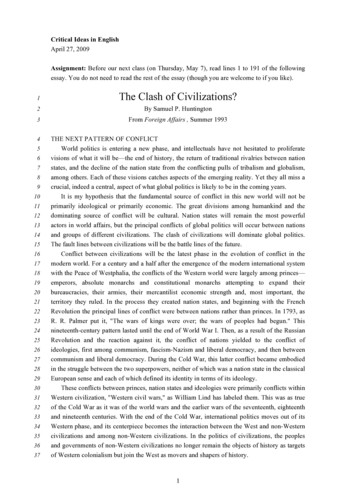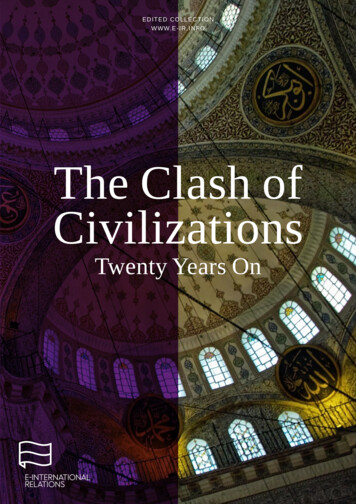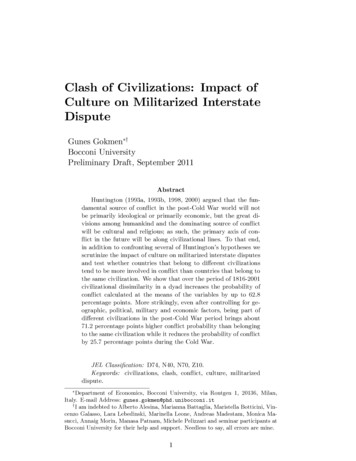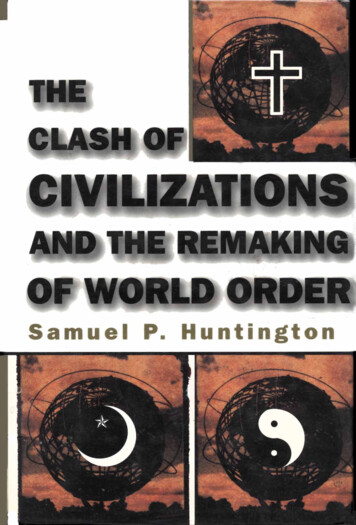
Transcription
Critical Ideas in EnglishApril 27, 2009Assignment: Before our next class (on Thursday, May 7), read lines 1 to 191 of the followingessay. You do not need to read the rest of the essay (though you are welcome to if you like).1The Clash of Civilizations?2By Samuel P. Huntington3From Foreign Affairs , Summer 19934THE NEXT PATTERN OF CONFLICTWorld politics is entering a new phase, and intellectuals have not hesitated to proliferatevisions of what it will be—the end of history, the return of traditional rivalries between nationstates, and the decline of the nation state from the conflicting pulls of tribalism and globalism,among others. Each of these visions catches aspects of the emerging reality. Yet they all miss acrucial, indeed a central, aspect of what global politics is likely to be in the coming years.It is my hypothesis that the fundamental source of conflict in this new world will not beprimarily ideological or primarily economic. The great divisions among humankind and thedominating source of conflict will be cultural. Nation states will remain the most powerfulactors in world affairs, but the principal conflicts of global politics will occur between nationsand groups of different civilizations. The clash of civilizations will dominate global politics.The fault lines between civilizations will be the battle lines of the future.Conflict between civilizations will be the latest phase in the evolution of conflict in themodern world. For a century and a half after the emergence of the modern international systemwith the Peace of Westphalia, the conflicts of the Western world were largely among princes—emperors, absolute monarchs and constitutional monarchs attempting to expand theirbureaucracies, their armies, their mercantilist economic strength and, most important, theterritory they ruled. In the process they created nation states, and beginning with the FrenchRevolution the principal lines of conflict were between nations rather than princes. In 1793, asR. R. Palmer put it, "The wars of kings were over; the wars of peoples had begun." Thisnineteenth-century pattern lasted until the end of World War I. Then, as a result of the RussianRevolution and the reaction against it, the conflict of nations yielded to the conflict ofideologies, first among communism, fascism-Nazism and liberal democracy, and then betweencommunism and liberal democracy. During the Cold War, this latter conflict became embodiedin the struggle between the two superpowers, neither of which was a nation state in the classicalEuropean sense and each of which defined its identity in terms of its ideology.These conflicts between princes, nation states and ideologies were primarily conflicts withinWestern civilization, "Western civil wars," as William Lind has labeled them. This was as trueof the Cold War as it was of the world wars and the earlier wars of the seventeenth, eighteenthand nineteenth centuries. With the end of the Cold War, international politics moves out of itsWestern phase, and its centerpiece becomes the interaction between the West and non-Westerncivilizations and among non-Western civilizations. In the politics of civilizations, the peoplesand governments of non-Western civilizations no longer remain the objects of history as targetsof Western colonialism but join the West as movers and shapers of 82930313233343536371
6364656667686970717273747576777879808182THE NATURE OF CIVILIZATIONSDuring the cold war the world was divided into the First, Second and Third Worlds. Thosedivisions are no longer relevant. It is far more meaningful now to group countries not in termsof their political or economic systems or in terms of their level of economic development butrather in terms of their culture and civilization.What do we mean when we talk of a civilization? A civilization is a cultural entity. Villages,regions, ethnic groups, nationalities, religious groups, all have distinct cultures at differentlevels of cultural heterogeneity. The culture of a village in southern Italy may be different fromthat of a village in northern Italy, but both will share in a common Italian culture thatdistinguishes them from German villages. European communities, in turn, will share culturalfeatures that distinguish them from Arab or Chinese communities. Arabs, Chinese andWesterners, however, are not part of any broader cultural entity. They constitute civilizations. Acivilization is thus the highest cultural grouping of people and the broadest level of culturalidentity people have short of that which distinguishes humans from other species. It is definedboth by common objective elements, such as language, history, religion, customs, institutions,and by the subjective self-identification of people. People have levels of identity: a resident ofRome may define himself with varying degrees of intensity as a Roman, an Italian, a Catholic, aChristian, a European, a Westerner. The civilization to which he belongs is the broadest level ofidentification with which he intensely identifies. People can and do redefine their identities and,as a result, the composition and boundaries of civilizations change.Civilizations may involve a large number of people, as with China ("a civilizationpretending to be a state," as Lucian Pye put it), or a very small number of people, such as theAnglophone Caribbean. A civilization may include several nation states, as is the case withWestern, Latin American and Arab civilizations, or only one, as is the case with Japanesecivilization. Civilizations obviously blend and overlap, and may include subcivilizations.Western civilization has two major variants, European and North American, and Islam has itsArab, Turkic and Malay subdivisions. Civilizations are nonetheless meaningful entities, andwhile the lines between them are seldom sharp, they are real. Civilizations are dynamic; theyrise and fall; they divide and merge. And, as any student of history knows, civilizationsdisappear and are buried in the sands of time.Westerners tend to think of nation states as the principal actors in global affairs. They havebeen that, however, for only a few centuries. The broader reaches of human history have beenthe history of civilizations. In A Study of History, Arnold Toynbee identified 21 majorcivilizations; only six of them exist in the contemporary world.WHY CIVILIZATIONS WILL CLASHCivilization identity will be increasingly important in the future, and the world will beshaped in large measure by the interactions among seven or eight major civilizations. Theseinclude Western, Confucian, Japanese, Islamic, Hindu, Slavic-Orthodox, Latin American andpossibly African civilization. The most important conflicts of the future will occur along thecultural fault lines separating these civilizations from one another.Why will this be the case?First, differences among civilizations are not only real; they are basic. Civilizations aredifferentiated from each other by history, language, culture, tradition and, most important,religion. The people of different civilizations have different views on the relations between Godand man, the individual and the group, the citizen and the state, parents and children, husband2
122123124125126and wife, as well as differing views of the relative importance of rights and responsibilities,liberty and authority, equality and hierarchy. These differences are the product of centuries.They will not soon disappear. They are far more fundamental than differences among politicalideologies and political regimes. Differences do not necessarily mean conflict, and conflict doesnot necessarily mean violence. Over the centuries, however, differences among civilizationshave generated the most prolonged and the most violent conflicts.Second, the world is becoming a smaller place. The interactions between peoples ofdifferent civilizations are increasing; these increasing interactions intensify civilizationconsciousness and awareness of differences between civilizations and commonalities withincivilizations. North African immigration to France generates hostility among Frenchmen and atthe same time increased receptivity to immigration by "good'' European Catholic Poles.Americans react far more negatively to Japanese investment than to larger investments fromCanada and European countries. Similarly, as Donald Horowitz has pointed out, "An Ibo maybe . an Owerri Ibo or an Onitsha Ibo in what was the Eastern region of Nigeria. In Lagos, he issimply an Ibo. In London, he is a Nigerian. In New York, he is an African." The interactionsamong peoples of different civilizations enhance the civilization-consciousness of people that,in turn, invigorates differences and animosities stretching or thought to stretch back deep intohistory.Third, the processes of economic modernization and social change throughout the world areseparating people from longstanding local identities. They also weaken the nation state as asource of identity. In much of the world religion has moved in to fill this gap, often in the formof movements that are labeled "fundamentalist." Such movements are found in WesternChristianity, Judaism, Buddhism and Hinduism, as well as in Islam. In most countries and mostreligions the people active in fundamentalist movements are young, college-educated, middleclass technicians, professionals and business persons. The "unsecularization of the world,"George Weigel has remarked, "is one of the dominant social facts of life in the late twentiethcentury." The revival of religion, "la revanche de Dieu," as Gilles Kepel labeled it, provides abasis for identity and commitment that transcends national boundaries and unites civilizations.Fourth, the growth of civilization-consciousness is enhanced by the dual role of the West.On the one hand, the West is at a peak of power. At the same time, however, and perhaps as aresult, a return to the roots phenomenon is occurring among non-Western civilizations.Increasingly one hears references to trends toward a turning inward and "Asianization" in Japan,the end of the Nehru legacy and the "Hinduization" of India, the failure of Western ideas ofsocialism and nationalism and hence "re-Islamization" of the Middle East, and now a debateover Westernization versus Russianization in Boris Yeltsin's country. A West at the peak of itspower confronts non-Wests that increasingly have the desire, the will and the resources to shapethe world in non-Western ways.In the past, the elites of non-Western societies were usually the people who were mostinvolved with the West, had been educated at Oxford, the Sorbonne or Sandhurst, and hadabsorbed Western attitudes and values. At the same time, the populace in non-Western countriesoften remained deeply imbued with the indigenous culture. Now, however, these relationshipsare being reversed. A de-Westernization and indigenization of elites is occurring in many nonWestern countries at the same time that Western, usually American, cultures, styles and habitsbecome more popular among the mass of the people.3
157Fifth, cultural characteristics and differences are less mutable and hence less easilycompromised and resolved than political and economic ones. In the former Soviet Union,communists can become democrats, the rich can become poor and the poor rich, but Russianscannot become Estonians and Azeris cannot become Armenians. In class and ideologicalconflicts, the key question was "Which side are you on?" and people could and did choose sidesand change sides. In conflicts between civilizations, the question is "What are you?" That is agiven that cannot be changed. And as we know, from Bosnia to the Caucasus to the Sudan, thewrong answer to that question can mean a bullet in the head. Even more than ethnicity, religiondiscriminates sharply and exclusively among people. A person can be half-French and halfArab and simultaneously even a citizen of two countries. It is more difficult to be half-Catholicand half-Muslim.Finally, economic regionalism is increasing. The proportions of total trade that wereintraregional rose between 1980 and 1989 from 51 percent to 59 percent in Europe, 33 percentto 37 percent in East Asia, and 32 percent to 36 percent in North America. The importance ofregional economic blocs is likely to continue to increase in the future. On the one hand,successful economic regionalism will reinforce civilization-consciousness. On the other hand,economic regionalism may succeed only when it is rooted in a common civilization. TheEuropean Community rests on the shared foundation of European culture and WesternChristianity. The success of the North American Free Trade Area depends on the convergencenow underway of Mexican, Canadian and American cultures. Japan, in contrast, facesdifficulties in creating a comparable economic entity in East Asia because Japan is a society andcivilization unique to itself. However strong the trade and investment links Japan may developwith other East Asian countries, its cultural differences with those countries inhibit and perhapspreclude its promoting regional economic integration like that in Europe and North America.Common culture, in contrast, is clearly facilitating the rapid expansion of the economicrelations between the People's Republic of China and Hong Kong, Taiwan, Singapore and theoverseas Chinese communities in other Asian countries. With the Cold War over, culturalcommonalities increasingly overcome ideological differences, and mainland China and Taiwanmove closer together. If cultural commonality is a prerequisite for economic integration, theprincipal East Asian economic bloc of the future is likely to be centered on China. This bloc is,in fact, already coming into existence. As Murray Weidenbaum has observed,158Despite the current Japanese dominance of the region, the Chinese-based economy of Asia is rapidly159emerging as a new epicenter for industry, commerce and finance. This strategic area contains160substantial161entrepreneurial, marketing and services acumen (Hong Kong), a fine communications network162(Singapore), a tremendous pool of financial capital (all three), and very large endowments of land,163resources and labor (mainland China). From Guangzhou to Singapore, from Kuala Lumpur to164Manila, this influential network—often based on extensions of the traditional clans—has been165described as the backbone of the East Asian gcapability(Taiwan),outstandingCulture and religion also form the basis of the Economic Cooperation Organization, whichbrings together ten non-Arab Muslim countries: Iran, Pakistan, Turkey, Azerbaijan, Kazakhstan,Kyrgyzstan, Turkmenistan, Tadjikistan, Uzbekistan and Afghanistan. One impetus to the revivaland expansion of this organization, founded originally in the 1960s by Turkey, Pakistan andIran, is the realization by the leaders of several of these countries that they had no chance ofadmission to the European Community. Similarly, Caricom, the Central American Common4
05206207208209210211212Market and Mercosur rest on common cultural foundations. Efforts to build a broaderCaribbean-Central American economic entity bridging the Anglo-Latin divide, however, haveto date failed.As people define their identity in ethnic and religious terms, they are likely to see an "us"versus "them" relation existing between themselves and people of different ethnicity or religion.The end of ideologically defined states in Eastern Europe and the former Soviet Union permitstraditional ethnic identities and animosities to come to the fore. Differences in culture andreligion create differences over policy issues, ranging from human rights to immigration to tradeand commerce to the environment. Geographical propinquity gives rise to conflicting territorialclaims from Bosnia to Mindanao. Most important, the efforts of the West to promote its valuesof democracy and liberalism as universal values, to maintain its military predominance and toadvance its economic interests engender countering responses from other civilizations.Decreasingly able to mobilize support and form coalitions on the basis of ideology,governments and groups will increasingly attempt to mobilize support by appealing to commonreligion and civilization identity.The clash of civilizations thus occurs at two levels. At the micro-level, adjacent groupsalong the fault lines between civilizations struggle, often violently, over the control of territoryand each other. At the macro-level, states from different civilizations compete for relativemilitary and economic power, struggle over the control of international institutions and thirdparties, and competitively promote their particular political and religious values.THE FAULT LINES BETWEEN CIVILIZATIONSThe fault lines between civilizations are replacing the political and ideological boundaries ofthe Cold War as the flash points for crisis and bloodshed. The Cold War began when the IronCurtain divided Europe politically and ideologically. The Cold War ended with the end of theIron Curtain. As the ideological division of Europe has disappeared, the cultural division ofEurope between Western Christianity, on the one hand, and Orthodox Christianity and Islam, onthe other, has reemerged. The most significant dividing line in Europe, as William Wallace hassuggested, may well be the eastern boundary of Western Christianity in the year 1500. This lineruns along what are now the boundaries between Finland and Russia and between the Balticstates and Russia, cuts through Belarus and Ukraine separating the more Catholic westernUkraine from Orthodox eastern Ukraine, swings westward separating Transylvania from the restof Romania, and then goes through Yugoslavia almost exactly along the line now separatingCroatia and Slovenia from the rest of Yugoslavia. In the Balkans this line, of course, coincideswith the historic boundary between the Hapsburg and Ottoman empires. The peoples to thenorth and west of this line are Protestant or Catholic; they shared the common experiences ofEuropean history—feudalism, the Renaissance, the Reformation, the Enlightenment, the FrenchRevolution, the Industrial Revolution; they are generally economically better off than thepeoples to the east; and they may now look forward to increasing involvement in a commonEuropean economy and to the consolidation of democratic political systems. The peoples to theeast and south of this line are Orthodox or Muslim; they historically belonged to the Ottoman orTsarist empires and were only lightly touched by the shaping events in the rest of Europe; they5
46247248249250251252253254255256257are generally less advanced economically; they seem much less likely to develop stabledemocratic political systems. The Velvet Curtain of culture has replaced the Iron Curtain ofideology as the most significant dividing line in Europe. As the events in Yugoslavia show, it isnot only a line of difference; it is also at times a line of bloody conflict.Conflict along the fault line between Western and Islamic civilizations has been going onfor 1,300 years. After the founding of Islam, the Arab and Moorish surge west and north onlyended at Tours in 732. From the eleventh to the thirteenth century the Crusaders attempted withtemporary success to bring Christianity and Christian rule to the Holy Land. From thefourteenth to the seventeenth century, the Ottoman Turks reversed the balance, extended theirsway over the Middle East and the Balkans, captured Constantinople, and twice laid siege toVienna. In the nineteenth and early twentieth centuries as Ottoman power declined Britain,France, and Italy established Western control over most of North Africa and the Middle East.After World War II, the West, in turn, began to retreat; the colonial empires disappeared;first Arab nationalism and then Islamic fundamentalism manifested themselves; the Westbecame heavily dependent on the Persian Gulf countries for its energy; the oil-rich Muslimcountries became money-rich and, when they wished to, weapons-rich. Several wars occurredbetween Arabs and Israel (created by the West). France fought a bloody and ruthless war inAlgeria for most of the 1950s; British and French forces invaded Egypt in 1956; Americanforces went into Lebanon in 1958; subsequently American forces returned to Lebanon, attackedLibya, and engaged in various military encounters with Iran; Arab and Islamic terrorists,supported by at least three Middle Eastern governments, employed the weapon of the weak andbombed Western planes and installations and seized Western hostages. This warfare betweenArabs and the West culminated in 1990, when the United States sent a massive army to thePersian Gulf to defend some Arab countries against aggression by another. In its aftermathNATO planning is increasingly directed to potential threats and instability along its "southerntier."This centuries-old military interaction between the West and Islam is unlikely to decline. Itcould become more virulent. The Gulf War left some Arabs feeling proud that Saddam Husseinhad attacked Israel and stood up to the West. It also left many feeling humiliated and resentfulof the West's military presence in the Persian Gulf, the West's overwhelming militarydominance, and their apparent inability to shape their own destiny. Many Arab countries, inaddition to the oil exporters, are reaching levels of economic and social development whereautocratic forms of government become inappropriate and efforts to introduce democracybecome stronger. Some openings in Arab political systems have already occurred. The principalbeneficiaries of these openings have been Islamist movements. In the Arab world, in short,Western democracy strengthens anti-Western political forces. This may be a passingphenomenon, but it surely complicates relations between Islamic countries and the West.Those relations are also complicated by demography. The spectacular population growth inArab countries, particularly in North Africa, has led to increased migration to Western Europe.The movement within Western Europe toward minimizing internal boundaries has sharpenedpolitical sensitivities with respect to this development. In Italy, France and Germany, racism isincreasingly open, and political reactions and violence against Arab and Turkish migrants havebecome more intense and more widespread since 1990.On both sides the interaction between Islam and the West is seen as a clash of civilizations.The West's "next confrontation," observes M. J. Akbar, an Indian Muslim author, "is definitely6
260going to come from the Muslim world. It is in the sweep of the Islamic nations from theMaghreb to Pakistan that the struggle for a new world order will begin." Bernard Lewis comesto a similar conclusion:261We are facing a mood and a movement far transcending the level of issues and policies and the262governments that pursue them. This is no less than a clash of civilizations—the perhaps irrational but263surely historic reaction of an ancient rival against our Judeo-Christian heritage, our secular present,264and the worldwide expansion of both.258259283Historically, the other great antagonistic interaction of Arab Islamic civilization has beenwith the pagan, animist, and now increasingly Christian black peoples to the south. In the past,this antagonism was epitomized in the image of Arab slave dealers and black slaves. It has beenreflected in the on-going civil war in the Sudan between Arabs and blacks, the fighting in Chadbetween Libyan-supported insurgents and the government, the tensions between OrthodoxChristians and Muslims in the Horn of Africa, and the political conflicts, recurring riots andcommunal violence between Muslims and Christians in Nigeria. The modernization of Africaand the spread of Christianity are likely to enhance the probability of violence along this faultline. Symptomatic of the intensification of this conflict was the Pope John Paul II's speech inKhartoum in February 1993 attacking the actions of the Sudan's Islamist government against theChristian minority there.On the northern border of Islam, conflict has increasingly erupted between Orthodox andMuslim peoples, including the carnage of Bosnia and Sarajevo, the simmering violence betweenSerb and Albanian, the tenuous relations between Bulgarians and their Turkish minority, theviolence between Ossetians and Ingush, the unremitting slaughter of each other by Armeniansand Azeris, the tense relations between Russians and Muslims in Central Asia, and thedeployment of Russian troops to protect Russian interests in the Caucasus and Central Asia.Religion reinforces the revival of ethnic identities and restimulates Russian fears about thesecurity of their southern borders. This concern is well captured by Archie Roosevelt:284Much of Russian history concerns the struggle between the Slavs and the Turkic peoples on their285borders, which dates back to the foundation of the Russian state more than a thousand years ago. In286the Slavs' millennium-long confrontation with their eastern neighbors lies the key to an understanding287not only of Russian history, but Russian character. To understand Russian realities today one has to288have a concept of the great Turkic ethnic group that has preoccupied Russians through the The conflict of civilizations is deeply rooted elsewhere in Asia. The historic clash betweenMuslim and Hindu in the subcontinent manifests itself now not only in the rivalry betweenPakistan and India but also in intensifying religious strife within India between increasinglymilitant Hindu groups and India's substantial Muslim minority. The destruction of the Ayodhyamosque in December 1992 brought to the fore the issue of whether India will remain a seculardemocratic state or become a Hindu one. In East Asia, China has outstanding territorial disputeswith most of its neighbors. It has pursued a ruthless policy toward the Buddhist people of Tibet,and it is pursuing an increasingly ruthless policy toward its Turkic-Muslim minority. With theCold War over, the underlying differences between China and the United States have reassertedthemselves in areas such as human rights, trade and weapons proliferation. These differencesare unlikely to moderate. A "new cold war," Deng Xaioping reportedly asserted in 1991, isunder way between China and America.7
34335336337338339340341342343344345The same phrase has been applied to the increasingly difficult relations between Japan andthe United States. Here cultural difference exacerbates economic conflict. People on each sideallege racism on the other, but at least on the American side the antipathies are not racial butcultural. The basic values, attitudes, behavioral patterns of the two societies could hardly bemore different. The economic issues between the United States and Europe are no less seriousthan those between the United States and Japan, but they do not have the same political salienceand emotional intensity because the differences between American culture and European cultureare so much less than those between American civilization and Japanese civilization.The interactions between civilizations vary greatly in the extent to which they are likely tobe characterized by violence. Economic competition clearly predominates between theAmerican and European subcivilizations of the West and between both of them and Japan. Onthe Eurasian continent, however, the proliferation of ethnic conflict, epitomized at the extremein "ethnic cleansing," has not been totally random. It has been most frequent and most violentbetween groups belonging to different civilizations. In Eurasia the great historic fault linesbetween civilizations are once more aflame. This is particularly true along the boundaries of thecrescent-shaped Islamic bloc of nations from the bulge of Africa to central Asia. Violence alsooccurs between Muslims, on the one hand, and Orthodox Serbs in the Balkans, Jews in Israel,Hindus in India, Buddhists in Burma and Catholics in the Philippines. Islam has bloody borders.CIVILIZATION RALLYING: THE KIN-COUNTRY SYNDROMEGroups or states belonging to one civilization that become involved in war with people froma different civilization naturally try to rally support from other members of their owncivilization. As the post-Cold War world evolves, civilization commonality, what H. D. S.Greenway has termed the "kin-country" syndrome, is replacing political ideology and traditionalbalance of power considerations as the principal basis for cooperation and coalitions. It can beseen gradually emerging in the post-Cold War conflicts in the Persian Gulf, the Caucasus andBosnia. None of these was a full-scale war between civilizations, but each involved someelements of civilizational rallying, which seemed to become more important as the conflictcontinued and which may provide a foretaste of the future.First, in the Gulf War one Arab state invaded another and then fought a coalition of Arab,Western and other states. While only a few Muslim governments overtly supported SaddamHussein, many Arab elites privately cheered him on, and he was highly popular among largesections of the Arab publics. Islamic fundamentalist movements universally su
14 and groups of different civilizations. The clash of civilizations will dominate global politics. 15 The fault lines between civilizations will be the battle lines of the future. 16 Conflict between civilizations will be the latest phase in the evolution of conflict in the 17 modern world. For a century and a half after the emergence of the .










